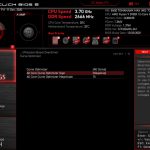Not long ago, AMD announced that it will introduce a new feature called Curve Optimizer as part of the Precision Boost Overdrive 2. According to AMD, this feature set should only come with AGESA 1.1.8.0., but it seems that AGESA 1.1.0.0. Patch D firmware on the MSI B450 Tomahawk motherboard already has the Curve Optimizer unlocked.
AMD had previously confirmed that the curve Optimizer update would be available in early January, but according to Wccftech, MSI claimed that MSI B450 Tomahawk will receive it in just a few days.
The screenshots give us a glimpse at how the Curve Optimizer feature works on the MSI B450 Tomahawk, which apparently has a Ryzen 9 5900X equipped. Unlike other Ryzen processor features that can be turned on in Ryzen Master software, Curve Optimizer is enabled on BIOS.
Image credit: Wccftech
Alongside the screenshots, the results of this system at stock and with Curve Optimizer feature configured were also compared. The BIOS settings were set to apply Curve Optimizer to all cores, the “All Core Curve Optimizer Sign” was set to “Negative”, and the “All Core Curve Optimizer Magnitude” was set to 15. The following table shows the results on Cinebench R20 nT and 1T benchmark running at stock and with Curve Optimizer enabled and configured.
| Curve Optimizer = Disabled | CPU frequency | CPU Temp | Cinebench R20 Score |
|---|---|---|---|
| Cinebench R20 nT | 4350-4550MHz | 72.3C | 8346 |
| Cinebench R20 1T | 4900MHz Max | 68.6C | 630 |
| Curve Optimizer = -15 | CPU frequency | CPU Temp | Cinebench R20 Score |
| Cinebench R20 nT | 4450-4675MHz | 72.1C | 8513 |
| Cinebench R20 1T | 4950MHz Max | 67.3C | 640 |
As per these results, we see that Curve Optimizer can increase performance while making the processor operate slightly cooler. The performance increase in Cinebench R20 single-thread and multi-thread benchmark has only increased by almost 2%, with the single-core frequency increasing by 50MHz, and the all-core frequency improving by 100-125MHz.
The system was also tested with “All Core Curve Optimizer Magnitude” set to 30, but made it become unstable because the Vcore was decreased to a value that didn't allow the Ryzen 9 5900X to run properly.
KitGuru says: Have you already bought a Ryzen 5000 series processor? Will you try Curve Optimizer once it is available for your motherboard?
 KitGuru KitGuru.net – Tech News | Hardware News | Hardware Reviews | IOS | Mobile | Gaming | Graphics Cards
KitGuru KitGuru.net – Tech News | Hardware News | Hardware Reviews | IOS | Mobile | Gaming | Graphics Cards




